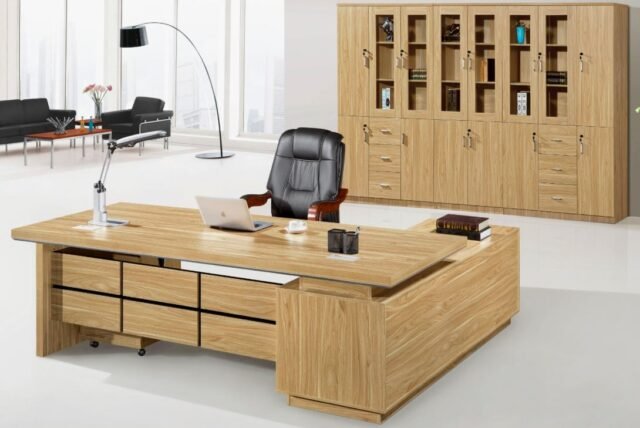The concept of workspace design has undergone a major transformation over the last few years. Companies are no longer viewing office interiors as merely functional spaces; instead, they are embracing the importance of design, style, and comfort to enhance productivity and employee well-being. A central part of this evolution is the office table design, which plays a key role in shaping the aesthetics and functionality of any office environment. From open-plan layouts to private cabins and collaborative workstations, the right office table sets the tone for efficiency and professionalism. With growing awareness about ergonomics and productivity, businesses are now investing in furniture that balances comfort, innovation, and style.
Importance of Choosing the Right Office Table
Selecting the right office table is far more important than it may appear at first glance. It impacts the daily productivity, mood, and even health of the person using it. Whether you are furnishing a startup’s workspace or upgrading a corporate office, the table you choose must accommodate both functionality and aesthetics. The perfect office table design is not just about surface space—it involves smart storage options, proper legroom, cable management features, and the right height for ergonomic alignment. A clutter-free, well-designed table enhances focus, reduces distractions, and reflects the company’s values and attention to detail.
Popular Office Table Designs in 2025
Trends in office table design continue to evolve with modern workspace needs. One of the most popular styles is the minimalist table, characterized by clean lines, neutral tones, and a focus on simplicity. These tables often come with built-in drawers, hidden cable ports, and matte-finish surfaces. Another trending design is the standing desk or adjustable-height desk, which allows users to switch between sitting and standing positions to improve posture and reduce sedentary strain. Collaborative tables with shared spaces and mobile modular units are also gaining popularity, especially in co-working environments. These designs foster team interaction while offering individual comfort and privacy.
Office Table Materials and Their Impact
The material used in an office table significantly affects its durability, appearance, and maintenance. Wood remains a classic choice due to its warm, professional look and sturdy build. Veneer-coated or laminated MDF boards offer a more affordable alternative, mimicking the appearance of solid wood while being lightweight and easy to clean. Metal-framed tables are ideal for industrial or tech-based environments, offering a modern, sleek aesthetic. Glass-topped office tables bring elegance and transparency to executive cabins, although they require more maintenance to remain spotless. Choosing the right material for your office table design depends on your brand identity, usage, and budget.
Ergonomics and Comfort in Office Table Design
One of the most critical aspects of office table design is ergonomics. Tables that are not aligned with ergonomic principles can cause a host of health issues, from back pain to eye strain and wrist injuries. Ergonomic office tables are designed with user posture in mind—they allow for proper hand placement when typing, appropriate screen height for eye level viewing, and ample legroom. Features such as adjustable heights, pull-out keyboard trays, and monitor stands further enhance comfort. Ergonomic design is not just a trend—it’s an essential requirement for any company looking to create a healthy and productive work environment.
Customization and Flexibility in Office Table Design
In today’s dynamic business world, flexibility and customization have become non-negotiable elements of workspace planning. Companies are moving away from one-size-fits-all furniture and opting for office table designs that can be customized according to department needs, user preferences, or spatial constraints. Modular tables allow you to expand or reconfigure layouts based on changing team sizes. Some modern office tables come with removable partitions or integrated tech features like wireless charging ports, USB hubs, and embedded lighting. Whether you need a compact desk for a small home office or an elaborate table system for a boardroom, custom solutions ensure the best fit and utility.
Sustainability in Office Furniture Design
Environmental responsibility is now a key factor in choosing office furniture. Many companies are opting for office table that use eco-friendly materials, recycled components, or sustainably sourced wood. Green-certified furniture suppliers provide documentation showing reduced environmental impact, which is increasingly important for businesses looking to enhance their sustainability profile. Moreover, well-constructed sustainable office tables often have a longer life span, reducing the need for frequent replacements and minimizing waste. Sustainable design is more than a trend—it reflects a brand’s commitment to the planet and can positively influence employee morale and client perception.
Office Table Designs for Different Workspaces
The choice of office table design should align with the nature and size of the workspace. For executive offices, larger desks with rich finishes, leather inlays, and premium materials convey authority and sophistication. For small startups or compact workspaces, corner desks or wall-mounted tables maximize space without compromising on functionality. Shared workspaces or hot-desking environments benefit from modular or folding tables that can be rearranged easily. Creative industries like design, media, or architecture often prefer larger tabletops for layout and sketching purposes. Each workspace type demands a tailored table solution that supports its unique workflows.
Tech Integration in Office Table Designs
In the digital age, technology integration has become a major consideration in office table designs. Many modern tables now come equipped with built-in cable trays, charging docks, power outlets, and data ports. This eliminates the clutter caused by wires and allows employees to keep their gadgets charged and ready without hassle. Some executive office tables include hidden compartments for laptops or smart lock drawers for security. Smart desks, integrated with sensors and apps, can even monitor posture, track standing time, and provide real-time ergonomic feedback. As workplaces become more digitized, table designs will continue to evolve in tandem.
Conclusion
Investing in the right office table design is a strategic decision that goes beyond appearance. It impacts how people work, how comfortable they feel, and how well they collaborate. Whether you’re designing a single office or an entire floor of workstations, choosing tables that reflect your company’s culture, support your workflow, and enhance productivity is key to long-term success. With countless options available in materials, features, and layouts, today’s businesses can create tailored environments that inspire innovation and efficiency. For those looking to transform their workspace with elegance and purpose, Modern Office Table Designs offers a perfect blend of style, functionality, and ergonomic excellence.







